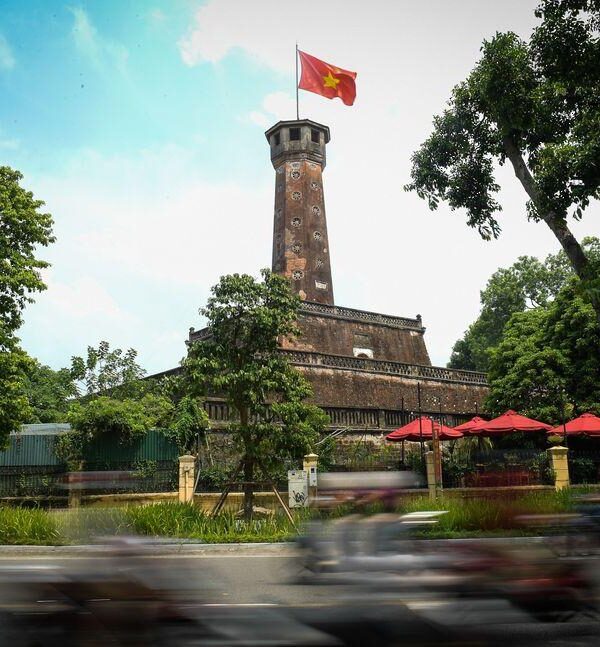Among the sights of Hanoi capital, Flag Tower of Hanoi is not only one of the long-standing historical sites but also a tourist destination not to be missed in your journey to discover the history of Hanoi.
Brief introduction about Flag Tower of Hanoi
The Flag Tower of Hanoi also has another name, Hanoi’s Ky Dai, built in the early 19th century. Over the years, but this work is still intact and the most valuable in the Imperial Citadel of Thang Long after the French and American war.

Built from 1805 to 1812 during the reign of King Gia Long of Nguyen Dynasty with the function of an observatory. The Flag Tower of Hanoi is a place to visit for many people of the capital as well as international tourists when traveling to Hanoi, taking souvenir photos.
The first interesting thing that most visitors when visiting Hanoi wants to come here is the unique and ancient architecture.
Where is Flag Tower of Hanoi?
Address: Dien Bien Phu Street, Ba Dinh District.
Ticket price: 20,000 VND / person.
Height: 33 m
Opening hours:
Visitors to Hanoi do not have to go too far, the flagpole is in the heart of Hanoi capital. To come here, just ask for directions to Cua Nam and Uncle Ho’s Mausoleum. From the shore of Hoan Kiem Lake to the Flagpole is less than 1km. Visitors can take a taxi or bus or rent a bicycle, walk to see the streets.
What’s special about the Flag Tower of Hanoi?
The entire Flag Tower of Hanoi is higher than 33m, including the flag pole, it is 44m. Here is a visit to both the outdoor and indoor. The interior is very spacious and airy, displaying guns and statues of Vietnamese national heroes.
The base floors The flagpole is square, gradually smaller, overlapping, and is covered with bricks. The balanced layout has created straight, solid lines for the Hanoi Flagpole. Especially during the hottest days of Hanoi, the temperature inside of the Flagpole is always cool.

On the roof of the flagpole is the national flag, an important symbol of national unity, and will be renewed after 2 to 3 weeks. Following the steps leading to the top of the flagpole, visitors can enjoy a view of the Military Museum’s tanks and helicopters and Le-nin Park.
With the design of the stone spiral staircase inside the flagpole, visitors can stop to look out the panoramic windows dotted along the curved walls. There are 3 separate observation decks and a pillar body, if you want to see the view, it’s best to move to the top observatory.

From the North of the flagpole, there are many ancient relics such as Doan Mon, Princess House, Cua Bac.
The East direction overlooks the Post Office and reflects down the historic Hoan Kiem Lake.
Looking to the west is Ba Dinh Square, Mausoleum, and Ho Chi Minh Museum of President.
South direction is an expanded space with much typical architecture of Hanoi.
From the top of the monument you can observe a large area inside and outside the ancient citadel. Except for the north door, the remaining three doors of the Ky Dai are engraved with their own names. The East door is “Nghenh huc” (to welcome the morning sunlight), the West door is “Hoi Quang” (reflected light), and the South door is “Huong Minh” (towards the light).
Places to visit near Hanoi Flagpole

Hanoi Opera House
This is one of the famous places to visit Hanoi with many historical marks. The Opera House is the venue for organizing great art programs for artists and singers. Besides, visitors can see firsthand the unique architecture of the theater.
Ba Dinh square
This is the political center of Vietnam with the National Assembly house, the Presidential Palace, Ho Chi Minh Museum, … and records many historical marks of Vietnam. The square is on Hung Vuong Street and in front of Ho Chi Minh Mausoleum. It is also the place where major public holiday parades take place.
Hoan Kiem lake
Hoan Kiem Lake is the top choice destination for tourists to enjoy the beautiful and ancient scenery of the lake surface, ancient temple roofs, ancient pagodas, old mossy towers, …
Hanoi Old Quarter
One of the interesting and attractive places for domestic and foreign tourists is Hanoi Old Quarter. This is home to 36 densely populated streets and you can walk around to buy souvenirs, enjoy rich cuisine.
Ceramic road
A ceramic road along the Red River is a work of art in the program welcoming the great celebration of 1000 years of Thang Long. The road becomes an indispensable destination for tourists every time they visit Hanoi.
Temple of Literature Quoc Tu Giam
Not only a thousand-year witness of the capital Hanoi, this place is a place that attracts a lot of tourists. Temple of Literature Quoc Tu Giam is a symbol of knowledge and education in Vietnam.
St. Joseph’s Cathedral, Hanoi
Is an old church in Hanoi with bold old French architecture, where religious activities of the parishioners of the archdiocese of Hanoi take place and is a tourist attraction attracting a large number of tourists.

